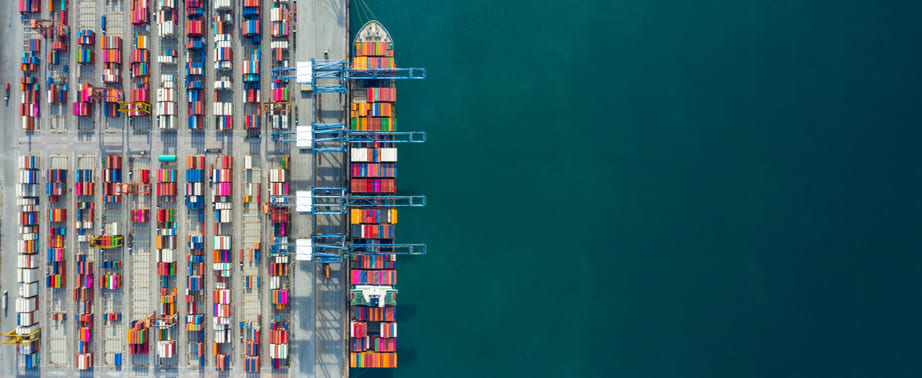Share this post
Transportation delays: The global shipping crisis explained
The world is currently experiencing a transportation crisis.
Transportation delays have become more common, and the situation is only getting worse. There are many reasons for this, but two of the biggest factors are China and the United States.
These two countries control the flow of the global container fleet, and they continue to face major problems right now. This has had a devastating effect on the transportation industry worldwide and the exporting and importing of goods.
The ongoing impact of COVID
The first reason for the transportation delays is that China, the world's largest exporter, has been hit hard by the global pandemic. Shanghai remains under lockdown, impacting suppliers, shippers and importers.
It all began when countries implemented lockdown measures in an attempt to contain the spread of COVID-19, which led to a halt in production and many factories closed temporarily. This caused a large number of containers to be stopped at ports, disrupting the flow of movement. As a result, carriers reduced the number of vessels out at sea to stabilize costs and the erosion of ocean rates, putting the brakes on import and export. It also meant empty containers weren’t picked up.
This was especially significant for China, which controls the majority of the world’s containers, because Asian traders couldn't retrieve empty containers from North America. Now, ports all over the world are congested as idle vessels sit in a backlog or traffic jam awaiting berth.
Other factors creating challenges include:
Blank sailings
Equipment imbalances
Increased fuel costs
Port omissions
Severe congestion
Altered vessel schedules
The impact of increased import volumes
The second reason for the delays is that the USA, the world's largest importer, has also been facing significant problems related to shipping delays in China.
U.S. importers have been scrambling to find replacement suppliers for goods outside of China, but this has not been easy. At the same time, they are also dealing with increasing import volumes because many U.S. consumers are continuing to buy more online - a new habit picked up during the pandemic.
This has led to overcrowding at U.S. ports and added to the ongoing haulage shortage. Import volumes are still at record levels in the U.S. with another monthly record.
Volumes in March were up 11% from February 2022 to almost 2.6 million TEUs. While reports show high import volumes in March, there has been an overall decrease in port delays, which helps ease congestion.
But as long as volumes remain above 2.4M TEUs, issues with congestion at ports will continue until changes are made to the infrastructure. A new report from the Biden administration recommends further investment in the inland waterway system to help ease congestion caused by persistent ship backlogs at U.S. ports.
Transportation delays due to container and vessel shortages
Many businesses worldwide are struggling with container shortages after the global pandemic created a North American bottleneck. When countries implemented lockdowns, many factories closed temporarily, which caused many containers to be stopped at ports.
In response, carriers reduce the number of vessels out at sea to stabilise costs and the erosion of ocean rates. Ports were also, forcing carriers to omit them.
Carriers would then have to discharge containers at alternate locations, disrupting schedules and impacting reliability.
A February 2022 report shows new container prices have fallen to $3,400 per TEU due partly to the high volume of containers produced through 2021, which has eased some of the shortage. While pricing has decreased, it's still above the pre-COVID high of $3,000 per TEU.
However, the price of used containers in the resale market remains high due to continued demand and decreasing availability. As congestion starts clearing and more boxes are released into service, older containers will be available for resale at a lower cost. But that hasn't happened yet.
In the meantime, industry experts don't see an end to port congestion anytime soon. The problem can't be solved by simply adding more capacity in regards to ships and containers, inland logistics and infrastructure needs investment too..
A port is only as good as the transportation network that feeds it. The Port of Los Angeles — the busiest seaport in the Western Hemisphere — has faced severe congestion. But the port reported its best first quarter ever, tracking 3.5% above last year's record.
Three months into 2022, overall cargo volume has reached 2,682,034 TEUs. This is attributed to improved fluidity on its docks and fewer vessels waiting to enter the port.
What's the biggest effect of transportation delays?
The biggest effect of transportation delays is its impact on global trade.
The world economy relies on the flow of goods and services, and when that flow is disrupted, it can have a major impact. We are already seeing this happen as businesses struggle to get the supplies they need.
This has led to further inflation as prices for goods increase. Transportation delays have also led to shortages of certain products.
If businesses can't get the supplies they need, customers will be left with empty shelves, leading them to turn to other businesses that can provide the products they need..
How to minimise the impact of transportation delays
The global shipping crisis is out of the control of even ocean carriers, who are at the mercy of container availability and congestion.
While it may not be possible to completely avoid transportation delays, there are some things that you can do to minimise the impact:
Mitigate risks with marine cargo insurance. This will provide peace of mind and financial protection in the event of loss or damage.
Diversify your supply chain. For urgent orders, consider alternative transport modes such as intermodal freight solutions, rail from Europe to Asia or airfreight for urgent orders.
Keep track of your inventory levels and adjust your orders accordingly. This will help you avoid running out of stock and dealing with even more delays.
Stay in communication with your suppliers and customers. This will help you manage expectations and keep everyone up to date on the latest developments.
How Hillebrand can help
Hillebrand has the experience and capability to provide you with end-to-end logistics solutions to help overcome transportation delays.
With vessels being stuck waiting to berth — sometimes up to 14 days, it’s important to factor this in when planning your shipments.
When delays occur at ports with fluctuating temperatures from day to night, we can help protect your wines and beers by using insulation liners that reduce fluctuations caused by temperature shifts.
We have temperature-controlled warehouses where you can store and consolidate your products safely.
Transportation delays can have a serious impact on your business, but there are things that you can do to minimise the damage. Stay informed, be proactive in your planning and you'll be able to weather this storm.

.png?sfvrsn=c3460e9d_1)



